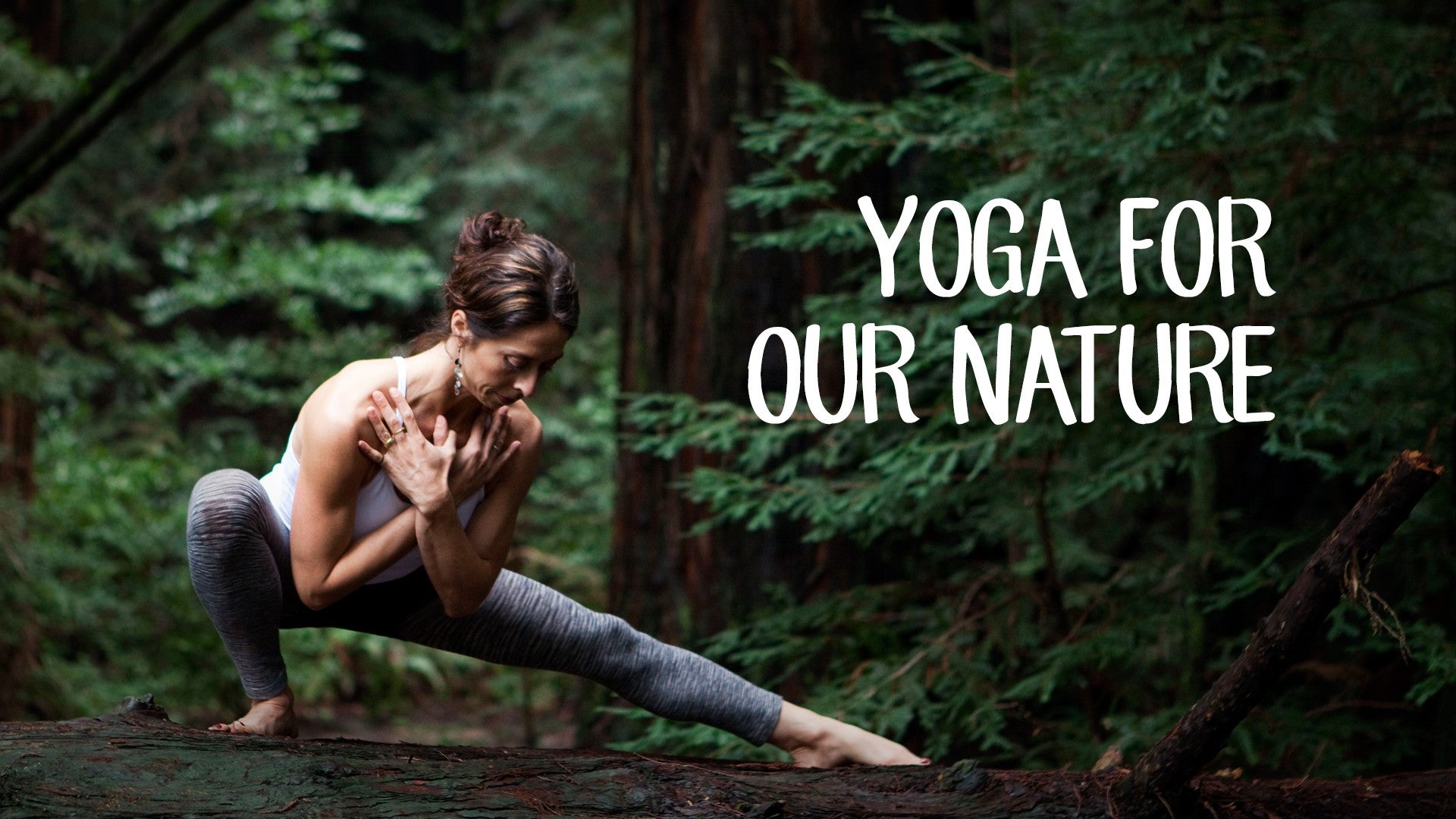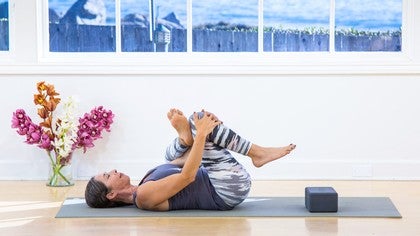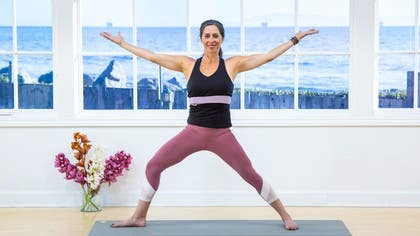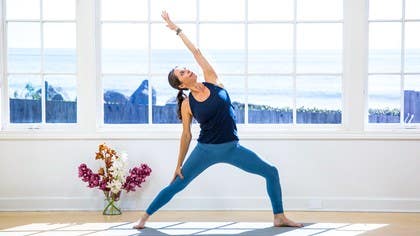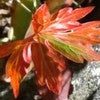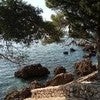Description
About This Video
Transcript
Read Full Transcript
Hello and welcome to the practice. Today I'll be covering yin yoga and as a topic in our yin yoga session today, I'll be covering the five elements. And my hope is that we'll be settling into each shape enough that you can identify some of the elements, earth, fire, water, space, and air, and to use the body as a way to anchor a little bit more into the present moment. So for class, what we might have for a basic practice of yin is a bolster and a block. And we'll start on the back and just know that each pose will be held for about four minutes and know that I'll be talking more at the beginning of the class and leaving some room for quiet time, silent time in poses as we move toward the end.
So if you appreciate talking, I'm going to support you. And if you appreciate silence, I also want to acknowledge that and support you as well. So for the first pose, if we get to a place where we can come down to our back with a block to support our feet. So if you come down onto your back and scoot as close to the block or as far away from the block as you need to, to allow your legs to drop out to the sides and let your arms move out to the side, whatever height feels best for you. And the idea in all of the yin poses is to investigate as soon as we meet the floor or the shape to explore, is it right?
Does it feel safe? So making any little minor adjustments so that your pose feels safe, recruiting more props if need be. And then as soon as you feel safe in the pose, if we can just tune in to where we're in touch with the floor and to try to anchor ourselves a little bit more in this way and to identify the earth element first and the earth element is that which gives us weight, that which helps us feel stable physically and ultimately mentally. Identify where you feel stable in your body, perhaps where you feel heavy. Maybe it's those places where you're making contact with the floor and feeling pressure where the buttocks meet the ground, shoulders meet the ground.
And try to feel how gravity takes you back into this pose and creates this unique shape, perhaps different each day. And if we were doing this practice out on the ground, if you imagine you're out on the earth, that you would not be of the earth, that you'd become one with the earth in this pose. That your spine become more connected to the earth and the earth's spine. Just feeling how that quality in the world, the earth quality out in what we see is also within our body. Same quality in the body.
And where you start to notice sensations arise in the body, can you direct more clearly your attention and your breath to accommodate all the changing sensations that you'll experience from one shape to the next? Being willing to adjust the breath, to meet the need of the rising sensation. Sometimes more, sometimes less. People where you are, take three more breaths without rushing or without hurrying and considering your connection to the ground, as you very mindfully start to bring the knees and legs in towards each other, transitions are part of the practice of staying mindful as we move from one pose to the next. Once your knees are parallel or touching, feet resting on the block, take a breath in and out.
Then we'll hang your right foot over to the outside of your left knee and the block might be helpful in our figure four shape with the legs or thread the needle shape. You can keep your foot on the block if that's better for your left leg, your left knee. Or reach forward and catch the back of your left leg or the front of your left shin and choose that as your pose. Please rock as you might need to side to side to just investigate is there a slightly better place to land and making sure the pose again feels safe and something that you can sink into. And as we begin to feel like we can sink into the pose, just notice your eyes, willingness to relax more, perhaps more willingness to relax the face, the jaw, the shoulders.
And as we move through the elements, we'll consider again that idea of sinking into the ground like a stone just settling here. And then try to observe the element of water. And some of the qualities of water we might know is it's liquid, it flows at times, perhaps it softens rough edges. And if we're in good space in the pose, we might feel like we're actually in the flow moment by moment. And we feel this water body starting to loosen up and we might feel like the water element is within the breath and hydrating deep tissues that feel rigid or brittle.
And see if you can sense as you're here and you've settled, if there are places that you can smooth out with that quality of water, places you might feel more fluid. And there might be the obvious muscles of the outer hips that tend to desire a little bit more moisture, fluidity, but you might feel this someplace different. So wherever your special place is that becomes more visible in this pose, can you imagine that quality of water moving through that space? You might notice the fluidity in the shape unfolding as you get more comfortable and we discover there's more levels to drop in. Sometimes it's nice to pay attention to places like the eyes and just check out the fluidity of the eyes.
Do they feel sufficiently lubricated here? Relax where they might be moving a little side to side. While keeping the eyes fluid and relaxed, the body fluid and relaxed, take three more breaths on this first side. When you're ready, we'll unleash the fingers around the left knee and put your left foot on the block and maybe the right foot on the block and just take a breath with your arms relaxed at your side. All right, we'll prepare to hang the left foot to the outside of the right knee and the block might be helpful to rest your right foot on for the whole pose or for some it might be better to lift your right foot, catch the back of your leg or front of your shin and invite that right leg to move towards your chest, towards the belly.
The first place we land isn't always the best spot, so please investigate your options of moving your body side to side, forward back until things feel safe. Now with the experience we've had together, you know that time again can make things more intense. So are we choosing a relatively conservative place to begin? We always trace the pose first back to the earth element and can you feel the points of contact with your head, your hips, shoulders, your spine and try to seek that connection to the earth. As we encourage that heaviness, that quality of heaviness, we move maybe a little bit slower in this practice, with the intention to go slow enough that we're really mindful breath to breath of what's changing and by holding that right knee, maybe starting to notice what becomes softer in your left side and can we try to tune in to that quality of water and flow and sense that there's some flow, some fluidity moving into your left side.
I always think of yin that it requires your intention, your imagination and your breath woven together to really make a difference and having the intention to allow that left side to be softer, more malleable and directing my breath towards that left hip again and again that eventually it might change, that those brittle places might feel more hydrated. So as we settle, can we also soften and just getting to know those qualities of earth and water a little bit more as we tend to the hips? As we tend to the hips, can we do that little checking back into the eyes and that they also feel fluid? Do you even notice the liquid in the mouth, the saliva in the mouth? As we hold the poses long enough, maybe even notice enhanced circulation in the outer left hip in this case.
So staying with that idea of softening into the shape as you take three more breaths. Without rushing, without hurrying, unleash your fingers and release the right foot to the block and then the left foot to the block. Take a breath in in your center position, slide the feet to the outside of the block and lift the block with your feet and set it behind you in case that will be helpful for the next pose. We're going to take your bolster and take it along the right side of your hip and when it's along that right side of the hip, take your right leg straight down to the floor, grab a hold of your left knee, bring it towards your belly and we'll roll into a twist where the outer left hip leaves the floor and your left knee lands on the bolster, the foot's on the bolster and we might stay completely turned over onto our right sides with your right left arm resting along your hip, along your side body. If we want to move a little further into shoulder stretch into the twist, we might take the block with your left hand and slide it as far over to the left as it feels appropriate so it's okay to turn the chest towards the ceiling.
Try to support yourself in a way where you're not overwhelmed in the twist and that you don't feel like you're creating any harm in that left shoulder, minimizing any harm in your spine. So when you feel you've explored your options, props or no props, take a moment to try to truly drop in and tune into the weight of the body. Tune into the quality of the earth underneath you, using that idea of water to soften any rough edges, to hydrate dry tissues, stiff muscles. As we add an extra layer of element, now the fire, and taking notice as we hold the pose of what might already feel like it's changing, what's transforming. Or perhaps we use the fire element to look at our precision of where we're placing our attention, our focus.
Perhaps using this as an opportunity to notice what intention you have for today's practice. Is there something you want to cultivate more of? Sometimes I think of a simple word like patience or kindness or joy, and perhaps you have your own word, but just something that might be meaningful to be focusing on to spark that fire element and keep the mind engaged. We might observe that fire element in the body as a presence of heat or lack of heat. The longer holds, it's pretty common to feel maybe more warmth in certain parts of your body, in this case maybe the left upper chest, maybe in your outer left hip.
So the presence of heat as we take a moment to identify the fire element in the body. Fire is responsible for digestion of information, food from the outside world becoming digested and integrated into your body. I'm taking the last three breaths here just to notice what you're digesting, how you're digesting information input from today. When you're ready, without hurrying or rushing, let that left arm slide on down to your side. Slowly roll onto your back for a moment maybe with your feet on the ground or legs straight just to pause in the center just to feel the effects of that twist.
Carry that bolster over to your outer left leg side and then take a moment when you're here to hold onto your right knee. Left leg is long and the bolster is pressed up against the side of that left leg. So anytime that you're ready, please roll over onto your left side and as you rest your right leg on the bolster, for some if there's any shoulder injuries, we might keep your right arm on your sides. Left hand helps hold the right knee onto the bolster. If you want to explore opening through that right shoulder and chest, perhaps grab a hold of your block and slide it far over to the other side of the room as you feel comfortable.
Take this one down to a different angle. So palm up or palm down, whichever feels safe for you. And if we have a little bit of tightness here with time, we might have more to dive into. So be a little conservative, be aware again that gravity will make this more intense. And try to find that slightly conservative edge to begin with.
We can always move the props aside later. When all the parts feel like they have the right support, can we then truly try to sink into the pose and try to be like a big stone here in this shape, really solid. Letting your attention run down this right side of the body and imagine that water element, that fluidity washing down over the right side, smooth away any rough edges. Perhaps noticing then that element of the fire, and can we reignite your intention, your focus, perhaps it's a quality that we try to cultivate. And maybe we repeat that word quietly to ourself in the spaces where there's quiet.
Sometimes I'll hold a pose and just be inhaling and using the word patience. Help me cultivate that quality that I find helpful in yin with yoga, with life. And as I exhale, perhaps saying that word patience, so I don't rush or hurry into what's next and I really truly let myself just be here. And maybe the word, the intention is helpful to orient your mind and your focus. And tuning in to the element of fire again and that quality of heat.
We feel that in different corners of the body, so certain areas that feel like they're changing with these longer holds. We think of the fire element as being responsible for transformation, for change. And sometimes the longer holds also can be intense and we think of fire as intense. We start to head into areas that feel intense, see if you can imagine more of that quality of water coming in to soothe, to calm. And then let's stay here, just observing three more breaths as you are.
So without hurrying or rushing, let yourself slowly work out of the pose, take your right arm down to your side and very slowly roll back onto your spine. And with your feet on the ground, just for a moment find that neutral place, observe the effect of that twist. With a block out of the way and allow your bolster to slide behind your head, it may or may not be necessary, but it could be helpful here behind your head, as we stretch the legs straight down to the floor. So I'm going to have you take your arms, your hands back to the top of the bolster and then slide your hands as far over to the right side of the room as you feel comfortable, so we're moving into a side arch and then we slide the feet a little bit more to the right. So I'm arching toward the right side and from the top ceiling view, it looks like I'm making kind of a crescent moon shape.
It can be helpful to take your left ankle foot over your right ankle to ground your right leg more to the floor. With your hands on potentially the bolster, we relax the shoulders and then the side bend and perhaps start to feel the outer left waist and chest opening. You find that spot where your head, your neck is not tense at all and then like we've been doing in all the pose, let's reference that earth element and sink back and all the places you can sink back, imagining that wash of water and fluidity going down that left side of your body and then being aware again of what might be warming up, what might be transforming as we observe the fire element and going back to your intention, your words as often as you need to as we tune into the next subtle element of air. And we think of air in the body as something that allows us to feel more flexible, allows us to be a little bit more adaptable moment to moment and perhaps in general just maybe a little more mobile. So it's about movement, the air, that which helps us move and see in this way in our pose that we can be aware of what's at a subtle level moving as we breathe in, what areas do you feel expanding, areas feel a little bit more mobile and as you exhale if you might feel that little wind of the breath coming up towards your nose and the wind of the breath going out of the nose, wind of the breath coming in, allowing some part of your body to open, to move.
So hopefully feeling that left side of the chest or shoulder area, feeling slightly more flexible with time and then using the breath to continue to orient yourself back into this moment, breathing in, breathing out as a way just to navigate a little bit further into the practice. For some people, adding a little more sound in the breath, that technique we call Ujjayi breathing might be helpful to stay a little bit more alert, so if that's helpful, allowing there to be more awareness of sound in the breath. Let's take three more breaths in the shape that you're in. Once we work our way out, if your left leg went on top of the right, release, let your legs be parallel, begin to slide your bolster, if you're using that a little bit more over to the left, then we might inch the shoulders a little bit more to the left and then slide your feet over to that left edge of your mat and then let's find the shape on the other side where we wiggle the shoulders, upper body to the left, so there's a crescent shape emerging from the top view, if you're looking at you from the top, perhaps taking that right ankle foot and crossing over your left ankle to help ground down your left side and perhaps bring a little more sensation into your outer right side and then going back to the basics of finding again where you can settle when the post feels right, can we actually sink back towards the earth as we settle again, tuning into the benefit of grounding here in the physical body, our physical body feels stable, a lot of times our mind might be a little bit less restless and at least we can have hope for that if it's not happening immediately that we might get there with practice and while it's feeling more graceful, more fluid as we soften and then noticing again the temperature, the sensations, is there heat in certain places in the body, is there more awareness of actually digesting something from the day, what's present and how might that fire element help you transform in this moment to let go of anything of the future, anything of the past and to be more interested in the next breath and feeling the wind of the air coming in and making space, creating a feeling of mobility through that right shoulder, the right side of your body, and the air elements a little more subtle than some of the other elements, so see if you can still again be curious about where the air breath, where the breath goes when it comes in, keeping track of that breath as the air moves up and out, allowing the body and that exhalation to feel maybe a little bit lighter, adapting as you might need to moment by moment to make this feel even better, micro adjustments might you make to really start to use these poses as meditation seats. The only difference might be is that we have a little more physical sensation that might help you draw your attention inward and downward and may those sensations be your focal points and they stay the focal point simply to help you develop and deepen that muscle of concentration. Let's take three more breaths in that pose. Your right leg went on top of the left, let's go ahead and release that right leg first, slide your feet in more to parallel and then take your right arm down to your sides, left arm down to your sides and we're going to make a big move and turn over onto your belly, so as you turn all the way around onto your belly, slide that bolster perhaps here onto your yoga mat and scoot your legs back, so now in this prone position we'll have the elbows and the hands up on the bolster, elbows out wide and I like to think of resting my forehead on my stacked hands and keeping those elbows lifted off the floor allows my shoulders and my upper chest area to get a little bit of stretch as we ease into what will be the first of two backbends.
If it's too much to have the elbows up on the bolster we simply move the bolster and do this without so your elbows could be on the floor. So take a moment in this way and feel your full body contact with the floor, the feet, legs, pelvis, belly, chest and then see what it's like to make that contact with the floor as you breathe in and feeling the pressure points for the bellies on the floor and can we encourage the weight of the legs and the ribs and the torso to sink and to almost melt here with the grace of gravity a little bit more into the floor. You can allow places to soften that we might feel rigid here in the backbend. I'm trying to identify the intention, the spark to keep your focus. As you take in enough, you can see that the backbend is a little bit more into the floor.
Hold your focus as you take in enough air in and out to continue to feed that flame that spark to hold your focus until we get to that last element of space. I like to think about that here in the yin as the spaces that exist between the breaths and see if you can observe those, tap into those as a way to move a little further into meditation. We're not holding the breath long periods of time, just simply touching that moment where you discover the end of the inhale and you discover the end of the exhale. Then we expand our capacity just to witness this moment without reacting, without desiring something more. It's that possibility of witnessing what I like to think of as the breath within the breath.
So there's a vitality in that pause. Let's take three more breaths, just tuning in to the space that's here as we do less. All right, we'll let the head, when you're ready, slowly come up away from the hands and begin to scoot the bolster further in towards your chest and we might need to wiggle it a little bit more forward or slide your body a little bit more forward. Everyone's torso is a little different length. So how to work around the bolsters where you could have your elbows in front of the bolster and have the support in sphinx pose. The front of the ribs have support, maybe the front of the chest has support as we let the spine lengthen through the natural curves. Until we come to that place where we've wiggled around and all the places we need to move, to get to that place where we become like that stone again and we sink a little bit deeper into the earth. Imagine again, we're not on the earth, try to remember that we are the earth and that quality of heaviness and stability is within us, especially gathered in those places like the bones, the teeth and nails, the firm places in the body. Like water out in the environment, that water is the same within us and it moves when we're in good space.
As it circulates through the body, again, hydrating, softening, providing the means for good circulation. And then that fire element in the pose, again, might keep us more focused, help us understand more clearly what we're focusing on moment by moment. Or the fire element might be easier to understand as the places where we feel that heat might feel it as we're digesting meals or thoughts and ideas. That element of fire out in the world is the same within our body. And then there's that gentle, subtle wind of air that moves, moves, creates mobility, flexibility, and allow your breath to modulate and adjust to the changing sensations.
Sometimes quiet breath, sometimes more audible breath. And you can stay close to the breath long enough and those spaces naturally arise when we do less. We have that curiosity to witness ourself in this moment and perhaps understand a little bit more the breath within the breath as a way to cultivate and understand the practice of meditation. Longer periods of held attention when we don't feel busy, when we don't feel rushed. Take three more breaths, just giving yourself space to be here, witnessing whatever is happening in the body, mind.
As we work our way out, we might consider lowering the chest and sliding the hands back beside the bolster or under the bolster and then using a little bit of strength to push up off the bolster and then slide your knees out to the sides and join the soles of the feet to touch. We're going to set the hips if it works for you to sit back towards your feet and take the bolster perhaps in front of you as a prop. Some of you will use it or maybe not use it as we come down with the belly, chest area, having a little bit of support and potentially again stacking your hands and resting your forehead here on your stacked hands or choose to do this without the bolster. I'm going to keep the bolster here just to show that option. If it's in your way, please go without the bolster. Can you see now if you can observe again places where you're in good contact with the earth. As you sink in, this place is where there's the fluidity, the water. Where there's heat, where there's intensity, where there's transformation, observing air coming in and out, and adapting to the needs of the body and sensations with more or less air coming in and out.
And then trying to get more comfortable in space, more awareness of self as we rest in the beauty of this moment and take our practice a little bit more into silence. So thank you. Please take three more breaths where you are here. And after your third breath, allow the head to come on up. Let your hands be outside the bolster and lift on up away from the ground just for a moment. Slide the bolster out of the way and then we'll work our way onto our back again and as you come onto the back, we'll use Shavasana as one of our yin poses. So I might encourage you to maybe turn your bolster the tall height or the flat height and in that way of turning it tall again, let the hamstring area kind of hold that bolster in place and so we have a little bit of lift underneath the legs to help hopefully settle your lower back. And just use this like all the poses as an opportunity to move closer to meditation and see if you can tap into the quality of earth in your body. In good space, let yourself soften and flow.
You're seeing heat or absence of heat. And being aware of what's transforming or transformed. Aware of air, aware of breath and this subtle prana without controlling the breath. Just aware of breath and then noticing space. And when there are no thoughts in the mind, no distracting sensations, there's just space.
And keep running through the elements as often as you need to as you settle. And try to hold steady and anchor in space. And please take three more breaths here without hurrying or rushing. And when you're ready, let your legs come in a little closer and we'll slide that bolster out of the way just for a moment. Use it again and then turn to your sides and then work your way up to an upright seat and we'll use in this upright seat your block turned potentially the medium height if we can sit in Virasana in this way. So knees come forward, medium block where we're sitting on and then take your bolster on top of your thighs and let your arms rest on the bolster.
So our final seat to see if all those little mini meditation poses help make this upright seat more comfortable. When the body's more comfortable maybe we notice the mind is more steady. So feel the bolster helping you ground your legs and notice the places where you're in touch with the earth and sink into the earth. Use that water again to soften rough edges. Using the fire to continue to spark your intention to stay alert and awake. And just enough awareness of the breath to feed that fire to keep your attention tuning inward as we try to discover the space between thoughts.
Space between breaths where you come back to really feel with your whole body what it's like to be present and to feel again your relationship with the elements and the natural world. That we are one again with all the elements. Please take three more breaths as you are here. I'm leaving the hands for a moment. Let your hands leave the bolster for a moment. Gather your hands together in front of the heart center and just acknowledging your efforts in practice to stay present.
And may our practice as always benefit others. Namaste and thank you so much. I hope to practice with you again soon.
Yoga for Our Nature: Vitality Boost
Comments
You need to be a subscriber to post a comment.
Please Log In or Create an Account to start your free trial.
